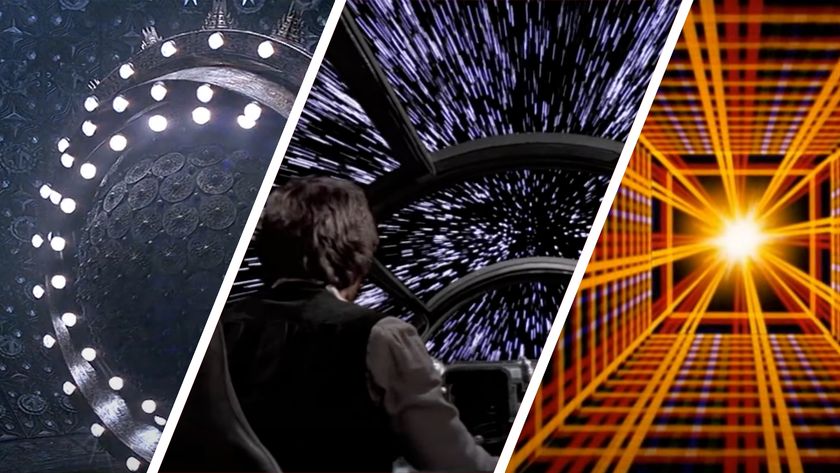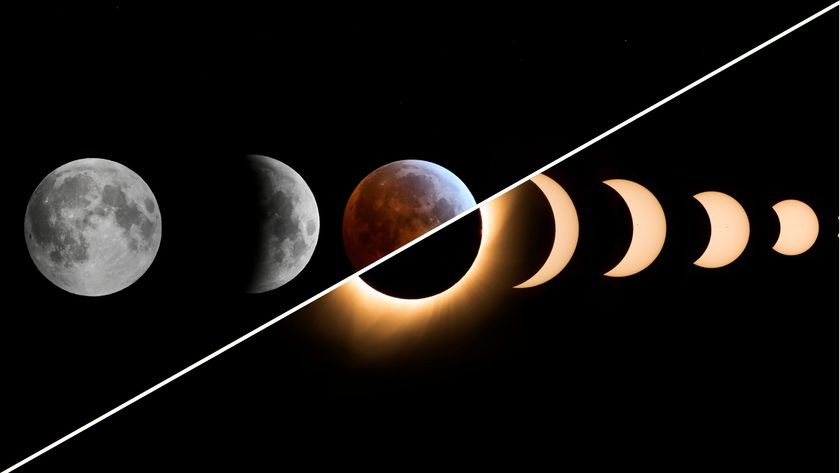What are binary stars?
Unlike the sun, most stars are part of a binary pair.
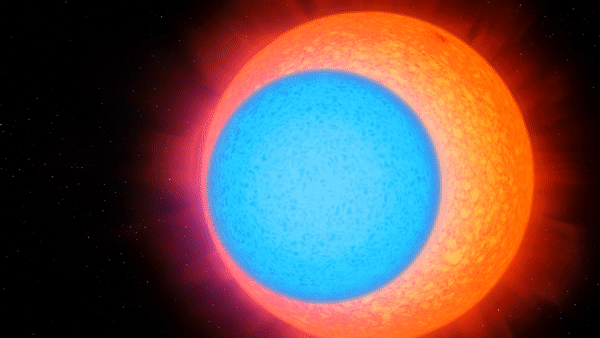
A binary star is a system of two gravitationally bound stars that orbit a common center of mass called a barycenter.
Stars in a binary system do not necessarily have the same mass, size or brightness. The larger star of a binary couple is called the primary star, while the smaller one is known as the secondary star or the companion star.
Related: What are star clusters?
Binary stars are double stars, but not all double stars are binary stars. This is because some double stars comprise two stars close enough in the sky over Earth to appear as a single point of light, but they are actually vastly separated in space and not part of a gravitationally bound binary system–these are called optical doubles.
Binary star FAQs
What is a binary star?
If a star is binary, it means that it's a system of two gravitationally bound stars orbiting a common center of mass.
Are binary stars rare?
No. It is estimated that around 85% of stars exist in binary star systems or systems with three or more stars. Single stars account for around 15% of all stars, but only 44% of stars that are similar to the sun are found with a binary partner, though this proportion is currently hotly debated.
Did the sun used to be a binary star?
Though the sun is currently a single star, research published in 2020 suggests that it could have once had a similar-size binary partner. Evidence for this theory comes from the fact that it would have been easier for binary stars to capture the Oort cloud, the shell of icy bodies that surrounds the outer limits of the solar system.
In 2018, a team of astronomers saw that the star HD 186302 is remarkably similar to the sun and could be our home star's stellar sibling or a "sun 2.0," with three other possible candidates highlighted.
How common are binary stars?
Unlike the sun, the vast majority of stars have a binary partner. The Australia Telescope National Facility estimates that up to 85% of all stars may exist in systems with two or three stars. So multistar systems are the norm, and binary systems are the most common multistar systems.
The chance of a star having a companion seems to diminish with its size, according to the book "Transiting Exoplanets" (Cambridge University Press, 2010). Around 75% of high-mass O-, B- and A-type stars seem to be found in multiple-star systems, roughly half of all known F- and G-type sunlike stars are found with a companion, and just 25% of small M-type red dwarf stars are found in multistar systems.
Binary star systems can also include systems containing a normal star and a stellar remnant, an object that forms when a star runs out of the fuel for nuclear fusion and collapses under its own gravity. These dense and compact star "corpses" can include white dwarfs, neutron stars and black holes. Especially ancient binary systems can contain two stellar remnants orbiting each other.
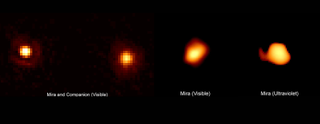
Who discovered binary stars?
The first observations of double stars were made in the early 17th century, but the binary nature of these objects was revealed later, according to the University of Oxford.
In 1767, astronomer and clergyman John Michell applied statistical principles to astronomy and studied the distribution of stars in the night sky. He determined that there were far more stars in pairs than could be accounted for if they were all randomly aligned, thus providing the first evidence for binary stars and star clusters.
In his 1781 catalog of 80 star systems, astronomer Christian Mayer proposed that "these stars could be small suns revolving around larger suns." However, astronomer and composer Frederick William Herschel was not convinced that double stars were composed of stars in physically bound systems, so he set about measuring the distances to these systems, using the principle of parallax, the observed displacement of an object caused by the change of the observer's point of view.
Herschel published his stellar catalog of 269 binary stars in 1782 and a second catalog of 434 more binaries in 1784. With the aid of his sister Caroline, Herschel observed the changes in the relative positions of these binary stars and published these observations in 1797. In 1803, he published a demonstration showing that these changes were the result of the stars existing in physical systems of mutual attraction, really bringing binary stars to the attention of the astronomical community.
Different types of binary star systems
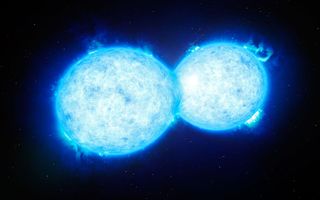
The distances between stars in binary systems and their orbital periods differ considerably from binary to binary, and a system can be defined by these orbital distances. Stars in binary systems can have orbital separations equivalent to thousands of times the distance between Earth and the sun; these are predictably called "wide binaries," according to "Transiting Exoplanets." (Cambridge University Press, 2010).
There are also "close binaries." The stars in these systems are often so close that they can exchange material, with the star losing matter called the "donor star" and the star gathering that matter called the "accretor." (Accretion is the process by which matter is fed to a celestial body, like a star, white dwarf, neutron star or black hole.)
Detached binaries are binary stars that do not exchange material. Semidetached binaries are stars in which some material flows from one star to the other. And contact binaries have stars so close together, their gaseous envelopes overlap. These latter stars may be in the process of merging, according to the book "Introduction to the Sun and Stars" (Cambridge University Press, 2015).
Orbital distance and matter exchange are not the only ways to categorize binaries, however. According to the Australia Telescope National Facility, there are four types of binary star systems categorized by the methods used to detect them.
Visual binaries
A visual binary is a binary star system in which the stars can be individually seen as separate bodies in a telescope from Earth. For this reason, most visual binaries are star systems that are closer to Earth. They also tend to be wide binaries, as these factors make the stellar components easier to resolve.
Because of the distance between them, the stars in visual binaries do not usually interact via the exchange of material. The brighter star of a visual binary is given the suffix "A," while the dimmer component is assigned the suffix "B."
Spectroscopic binaries
When a binary system is too distant, or when the stars are too close together, the stellar bodies cannot be resolved separately by a telescope as with visual binaries. However, astronomers can use a phenomenon called Doppler shift to distinguish the stars in these binary systems, which are called spectroscopic binaries.
Doppler shift works because the wavelengths of light are shortened when a star is moving toward Earth, shifting it toward the blue end of the electromagnetic spectrum, while light from a star moving away from our planet has its wavelength stretched, or "redshifted."
A binary system emits light that is the combined light output, or "spectra," from both of its stellar components. If star A is moving away from Earth and star B is moving toward us, or vice versa, the individual spectra of these stars can be resolved by their red or blue shift. As observations of this binary continue and the stars proceed in their orbits, this situation will be reversed: As star A begins to move toward Earth, its light is then redshifted, and as star B begins to move away from our planet, its spectrum is blueshifted.
Spotting a spectroscopic binary relies heavily on several conditions being met. Most significantly, the orbital plane of the binary cannot be at a right angle to our line of sight, and the stars must not move across that line of sight because this stops the Doppler shift from being visible.
The chance of spotting a spectroscopic binary is reduced if the stars of a binary system are low-mass or if they are widely separated and thus have a long orbital period that lowers the probability of catching one star moving away from us and the other moving toward us. The chance of seeing a star binary as a spectroscopic binary is also lowered if one of the stars is dim and thus makes little contribution to the combined light from the system.
Despite these hindrances, most known binary star systems were spotted using their Doppler shifts.
Eclipsing binaries
Some stars demonstrate a periodic change in the magnitude of their brightness. This may be triggered when the star changes its intrinsic light output, as in the case of a pulsating variable star, or it could be because the star is a binary system viewed edge-on, meaning one star is periodically eclipsing the other. These are called eclipsing binaries.
Eclipsing binaries can also fit into the two previously mentioned categories and are often so close together that they exchange material.
Astrometric binaries
A companion star in a binary system can have an effect on its partner other than altering its light output. Though the two stars orbit a common center of mass, an unseen star can gravitationally "tug" on the other. This causes a periodic "wobble" in the visible star's motion over time. The precise measurement of a star's motion and position is called "astrometry," so binaries spotted in this way are known as astrometric binaries.
How do binary star systems evolve?
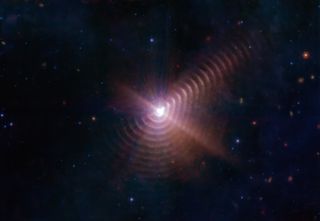
As mentioned above, in some binary systems, the stars are so close together that they exchange material. This mass transfer occurs when the radius of one star is not much smaller than the orbital separation between the stars.
This can proceed in several ways, according to "Introduction to the Sun and Stars." One mechanism, called Roche-lobe overflow, is particularly important. Each star in a binary system is surrounded by a theoretical pear-shaped volume called a Roche lobe, the size of which is determined by the mass of the star. When a donor star, usually a giant one, fills its Roche lobe, material flows from it through a gravitationally stable point called an inner Lagrangian point to the accretion star — often a white dwarf or other compact stellar remnant. As it enters the Roche lobe of the donor star, this matter still has angular material, so it can't go straight to the surface of the accretor. As such, it forms a stream of gas and dust on one side of the receiving star or an accretion disk from which it is gradually fed to the surface of the accretor star.
With a contact binary, both stars have filled their Roche lobes with the more massive star, sending material to its smaller companion but also sharing brightness and temperature.
Binary stars can also exchange material even if neither star fills its Roche lobe. This happens via stellar wind accretion, a process in which the accretor captures the stellar wind blowing from the donor star, usually a massive one.
The exchange of mass between stars can have a significant impact on the evolution of these systems and their stellar components. For instance, in a binary system with two main sequence stars, when the more massive star runs out of nuclear fuel and puffs out as a red giant filling its Roche lobe, it starts transferring matter to the other star. As the matter is transferred, the red giant loses mass, causing its Roche lobe to shrink and driving the mass transfer to proceed faster.
This can completely deplete the donor star's outer layers, leaving it as an exposed helium star on the path to becoming a white dwarf or a neutron star. This results in a binary system with a large main sequence star and a compact stellar remnant. This will not be the case forever, though. Eventually, after millions — or even billions — of years, the second star will also enter a red giant phase, filling its own Roche lobe, which causes it to start sending material to its white dwarf or neutron star companion.
Because of the incredible density of these stars, when matter falls onto them, it releases a huge amount of energy that can trigger thermonuclear reactions at the surface of that compact stellar remnant. In some cases, the accretion of matter from a red giant to a white dwarf can cause it to blast out a Type Ia supernova or can push it over the mass limit needed to transform it into a neutron star.
Do binary star systems host planets?
Extrasolar planets, or exoplanets, are planets that orbit stars other than the sun. Binary systems can possess exoplanets in stable orbits, some of which are closer to one star in the binary and thus orbit that star much as Earth orbits the sun, in what is called a circumstellar orbit. Other exoplanets in binary star systems have more unusual orbits, looping both of the stars in that system. Exoplanets that orbit an entire binary system in this way are said to possess "circumbinary orbits."
The first circumbinary planet discovered was PSR B1620-26 b, which was first hinted at in 1993 and was finally confirmed to exist in 2003. This planet's circumbinary orbit carries it around a white dwarf and a neutron star located around 12,400 light-years from Earth. The advanced stellar evolutionary status of the stellar occupants of this exotic system means it is believed to be around 12 billion years old, making PSR B1620-26 b potentially the oldest exoplanet discovered thus far and earning it the nickname Methuselah after the biblical figure who lived to a remarkably old age.
The first circumbinary planet discovered around a binary star young enough to still be burning hydrogen in its core, a so-called main sequence star," was discovered in 2011. Called Kepler-16 b, it orbits a main sequence star smaller than the sun as well as a red dwarf.
Astronomers aren't yet sure how existing in a binary star system would affect the habitability of a planet. In 2022, researchers looked at how habitable planets could possibly form in binary star systems. Focusing on a pair of young protostars still gathering the mass needed to trigger hydrogen fusion and become true stars in the binary system NGC 1333-IRAS2A, the team found that habitable planets could emerge around binaries but they would do so differently than those in single-star systems. This is because the complex behavior of young twin stars affects flattened clouds of planet-forming material around them called protoplanetary disks, distorting those disks with periodic outbursts of energy.
Also more complex is the calculation of where a habitable zone in or around a binary star system would be for an exoplanet. The habitable zone is the area around a star that is neither too hot nor too cold to allow for the existence of liquid water on an orbiting planet's surface — hence why it is often called the Goldilocks zone. This is tricky to estimate for binary star exoplanets because the distances between the planet and the stars change continuously — more so than for planets on elliptical orbits around a single star. This means the amount of starlight received by these exoplanets can vary substantially, and thus so can their surface temperatures.
In research conducted in 2007, scientists concluded that 50% to 60% of binary star systems could form planets with the necessary conditions needed to support life. With the Milky Way packed with 100 billion star systems, there are potentially many planets where life could exist under the glare of two "suns," similar to the fictional planet of Tatooine as strikingly depicted in "Star Wars."
Binary star expert Q&A
We asked Vik Dhillion, Professor of Astrophysics in the Department of Physics and Astronomy at the University of Sheffield, some questions about binary stars.
Vik Dhillon is a Professor of Astrophysics in the Department of Physics and Astronomy at the University of Sheffield. Dhillon's primary research interests are in the field of close binary stars.
How common are binary star systems?
About half of all stars in the sky are binary!
What happens during the development of a star system to create binary stars rather than a single star?
Stars are typically formed in clusters of hundreds to thousands, and many of these form as binary stars during this process.
Can binary systems break apart?
Yes, if one of the stars goes supernova or if there is a close encounter with a third star.
How does your work relate to binary star systems?
I study close binary stars — these are when the two stars in the binary system are separated by of order the diameter of the Sun (just over a million km). These are particularly interesting, as the closeness of the two stars means they can't evolve independently like single stars, and you get mass transferring between (and even merging of) the two star
What is fascinating about these systems?
Close binary stars are interesting because the mass transfer and/or merging results in some of the most exotic inhabitants of our universe, like supernovae and short gamma-ray bursts.
It is in these types of objects that the heaviest elements in the Universe are formed.
Additional resources
A simulation shows how stars exchange material through a stable gravitational point via a process called Roche lobe overflow. Another simulation, created by NASA, shows what happens in a binary system that has evolved to the point at which both components are neutron stars.
Bibliography
Binary stars, Australia Telescope National Facility, [accessed 10/10/23], [https://www.atnf.csiro.au/outreach/education/senior/astrophysics/binary_intro.html]
Types of binary stars, Australia Telescope National Facility, [accessed 10/10/23], [https://www.atnf.csiro.au/outreach/education/senior/astrophysics/binary_types.html]
Multiple Star Systems, NASA, [accessed 10/10/23], [https://universe.nasa.gov/stars/multiple-star-systems/]
Binary star, Britannica, [accessed 10/10/23], [https://www.britannica.com/science/binary-star]
Binary Stars, Philosophy of Cosmology, Oxford University, [http://philosophy-of-cosmology.ox.ac.uk/binary-stars.html]
S.F. Green., M. H. Jones., Introduction to the sun and stars, Cambridge University Press, [2015], ISBN 978 1 107 49263 9
S. G. Ryan., A.J. Norton., Stellar evolution and nucleosynthesis, Cambridge University Press, [2010], ISBN 978 0 521 13320 3
C. A. Haswell., Transiting Exoplanets: Measuring the properties of planetary systems, Cambridge University Press, [2010], ISBN 978 0 521 13938 0
Join our Space Forums to keep talking space on the latest missions, night sky and more! And if you have a news tip, correction or comment, let us know at: community@space.com.
Get the Space.com Newsletter
Breaking space news, the latest updates on rocket launches, skywatching events and more!

Robert Lea is a science journalist in the U.K. whose articles have been published in Physics World, New Scientist, Astronomy Magazine, All About Space, Newsweek and ZME Science. He also writes about science communication for Elsevier and the European Journal of Physics. Rob holds a bachelor of science degree in physics and astronomy from the U.K.’s Open University. Follow him on Twitter @sciencef1rst.








